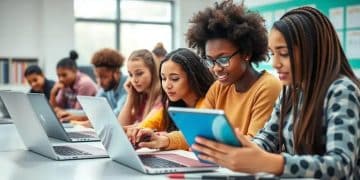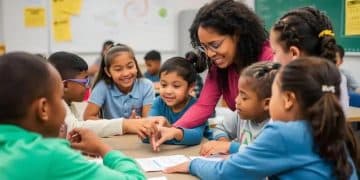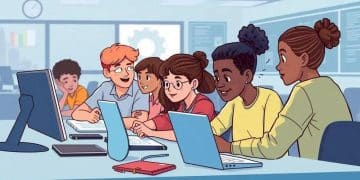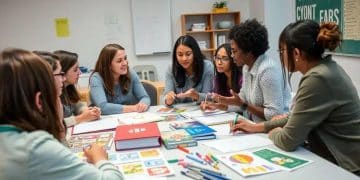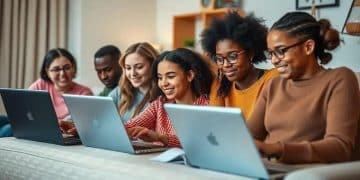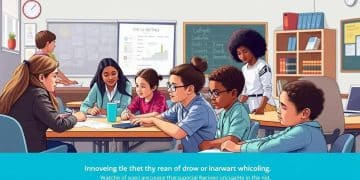Remote learning: explore new ways to engage students

Anúncios
Remote learning presents challenges such as lack of interaction and technical issues, but effective strategies like interactive tools and regular feedback can enhance student engagement and improve educational outcomes.
Remote learning has transformed the educational landscape, providing unique opportunities for both students and educators. Have you ever wondered how this method can reshape the way we learn? Let’s dive into how remote learning can optimize education.
Anúncios
Understanding the concept of remote learning
Understanding the concept of remote learning is essential in today’s educational environment. This approach allows students to learn from anywhere, providing flexibility and accessibility.
The traditional classroom setup is shifting towards online platforms where students can engage in their studies effectively. This method relies heavily on technology and the internet, creating numerous opportunities for learners.
Key Components of Remote Learning
To understand remote learning better, it is crucial to explore its key components:
Anúncios
- Technology: This includes computers, tablets, and reliable internet access.
- Learning Management Systems (LMS): Platforms like Moodle, Google Classroom, or Canvas facilitate course organization.
- Interactive Tools: Video conferencing apps like Zoom or Microsoft Teams enable live interactions between students and teachers.
- Self-Motivation: Students must be proactive in their learning journey to succeed in a remote setting.
The effectiveness of remote learning also depends on the communication strategies employed by educators. Clear instructions and regular feedback help maintain student engagement. Additionally, incorporating various multimedia resources can enhance learning experiences.
As students navigate through remote learning, they often discover new ways to study that suit their unique learning preferences. The diverse tools available encourage creativity and independent problem-solving.
Benefits of Remote Learning
The benefits of this approach are numerous. It allows students to tailor their study environments, which can lead to increased focus and retention of information. Furthermore, remote learning can help students balance their academic responsibilities with personal commitments.
Ultimately, understanding remote learning opens doors to innovative educational practices, making education more inclusive. As we embrace this shift, we will witness a transformation in how knowledge is shared and acquired.
Effective tools for remote student engagement
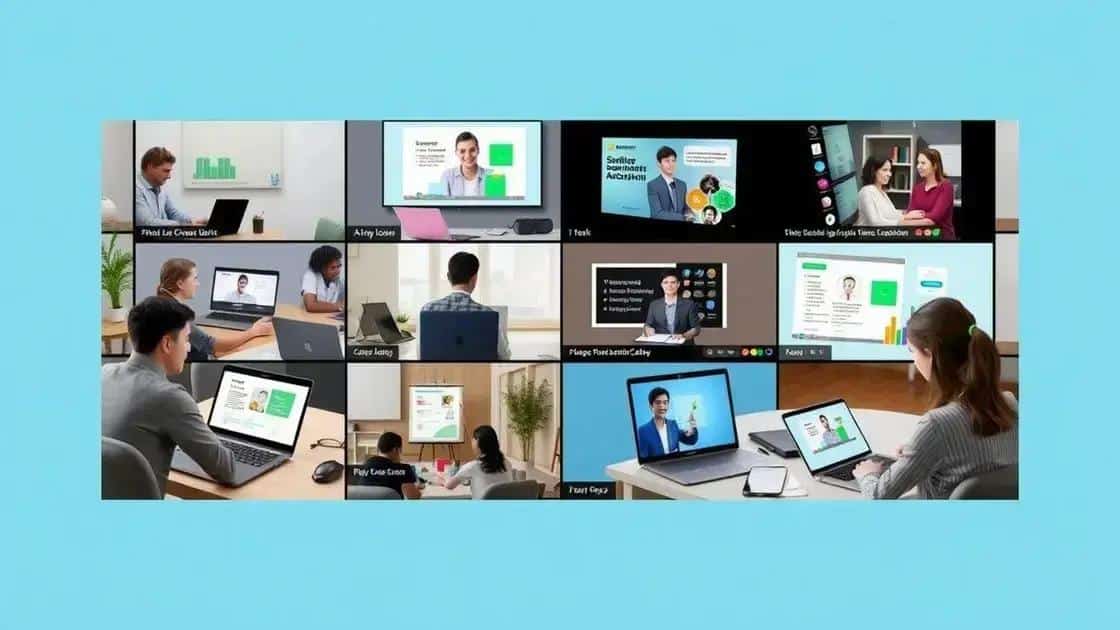
Effective tools for remote student engagement play a vital role in the success of online education. Using the right technology can make learning more interactive and enjoyable.
Many educators are discovering how innovative software enhances communication between teachers and students. For instance, video conferencing platforms are popular for real-time discussions and lessons.
Popular Tools for Engagement
Some of the most effective tools include:
- Zoom: This platform enables live classes and discussions, fostering a sense of community.
- Kahoot: A game-based learning platform that makes quizzes fun and engaging.
- Google Classroom: It helps organize assignments and facilitates feedback between students and teachers.
- Miro: A collaborative whiteboard tool that allows creative brainstorming and project planning.
These tools not only help in maintaining participation, but they also provide valuable insights into student performance. Teachers can track progress and identify areas where students may need extra help.
As students engage with technology, their learning experience becomes more personalized. For instance, many platforms offer adaptive learning features, allowing students to learn at their own pace.
Enhancing Interaction in Online Classes
To increase engagement, educators can use various strategies. Implementing breakout rooms in video calls can create small group discussions, allowing students to connect and share ideas. Additionally, incorporating polls and interactive quizzes keeps the learning atmosphere lively.
Moreover, feedback is crucial in remote learning. Regular check-ins and open communication help educators understand students’ needs and adjust their teaching methods accordingly.
In summary, effective tools and strategies for remote student engagement are essential for creating an enriching educational experience. By embracing technology, teachers can inspire and motivate their students.
Strategies to enhance interaction in online classes
Strategies to enhance interaction in online classes are essential for keeping students engaged and motivated. When learners feel connected, they are more likely to succeed in a remote learning environment.
One effective method is to use interactive tools during lessons. Applications that allow real-time feedback keep the experience dynamic and encourage students to share their thoughts.
Interactive Techniques
Here are some interactive techniques that can be employed:
- Polls and Surveys: Using tools like Mentimeter or Google Forms, teachers can gauge students’ understanding and adapt the lesson accordingly.
- Breakout Rooms: Utilize breakout rooms in video conferencing tools to facilitate small group discussions, allowing for more intimate exchanges of ideas.
- Gamification: Incorporating game elements in learning can make lessons fun and help students stay engaged.
- Discussion Boards: Platforms like Padlet allow students to post questions and ideas, fostering a sense of community.
Another way to enhance interaction is by scheduling regular check-ins with students. This offers an opportunity to discuss academic and social issues, creating a supportive classroom culture. Educators can also encourage peer feedback, which not only improves collaboration but also empowers students to take ownership of their learning.
Encouraging Engagement
To further engage students, consider varying the types of content shared during classes. Incorporating multimedia, such as videos and podcasts, can cater to different learning styles, making lessons more relatable. Additionally, maintaining an open line of communication is crucial. Students should feel comfortable reaching out with questions or concerns.
Establishing clear expectations for participation can also motivate students to engage consistently. For instance, outlining how often students should contribute in discussions or complete assignments can guide them effectively.
Overall, using diverse strategies to improve interaction in online classes leads to a more enriching educational experience. By prioritizing connection and communication, educators can help students thrive in remote learning environments.
Challenges and solutions in remote learning
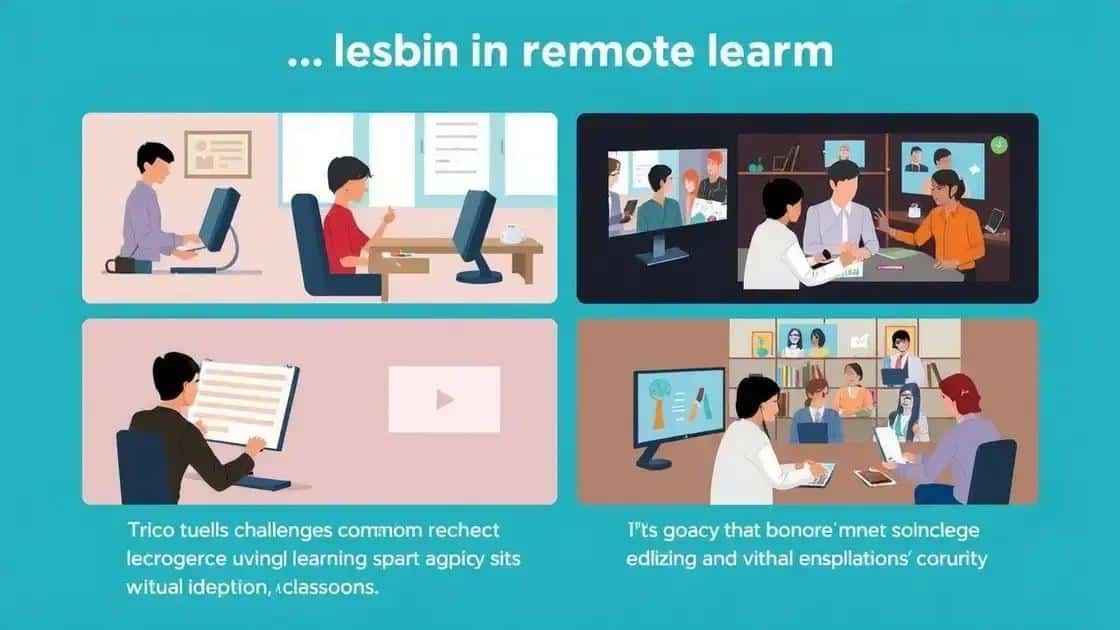
Challenges and solutions in remote learning are critical to understanding how to improve the educational experience. While this approach provides flexibility, it also poses unique obstacles for students and teachers alike.
One significant challenge is the lack of face-to-face interaction. Many students miss the personal connection they have in traditional classrooms. This can lead to feelings of isolation and disengagement. However, using video conferencing tools can help bridge the gap by allowing real-time communication between teachers and students.
Common Challenges
Some of the most common challenges include:
- Technical Issues: Students may face poor internet connectivity or lack the necessary devices.
- Time Management: Without a structured schedule, students might struggle to keep up with their studies.
- Engagement Levels: It can be harder to maintain student interest during online classes.
- Access to Resources: Limited resources can hinder learning opportunities for some students.
To address these issues, educators can implement various solutions. For example, providing clear guidelines on using technology can help minimize technical difficulties. Holding workshops for students and parents on time management skills can also prove beneficial.
Strategies for Overcoming Challenges
Another effective strategy is to create engaging content that promotes interaction. Utilizing breakout sessions during video calls encourages collaboration among students. Additionally, offering flexible deadlines can alleviate pressure, allowing students to manage their time better while still meeting learning objectives.
Teachers should also be encouraged to seek feedback from students. Regular surveys can help identify which areas are challenging and what resources may be needed to assist them. This creates a sense of community and empowers students to take an active role in their education.
Ultimately, while there are significant challenges in remote learning, implementing thoughtful solutions can help overcome them, making the learning experience more effective and enjoyable for everyone involved.
remote learning is essential for creating an effective education experience. While obstacles such as lack of interaction and technical issues can arise, implementing strategies like interactive tools, regular feedback, and flexible deadlines can greatly enhance student engagement. By embracing these solutions, both educators and students can navigate this learning environment more successfully and foster a productive, inclusive online classroom.
FAQ – Frequently Asked Questions about Remote Learning
What are the main challenges of remote learning?
Some of the main challenges include lack of face-to-face interaction, technical issues, and maintaining student engagement.
How can educators enhance student engagement in online classes?
Educators can use interactive tools, gamification, and small group discussions to boost engagement and create a dynamic learning environment.
What strategies can help address technical difficulties?
Providing clear instructions on using technology and holding workshops for students can help minimize technical difficulties.
Why is feedback important in remote learning?
Feedback is crucial as it helps identify student needs and areas for improvement, facilitating a more effective learning experience.

